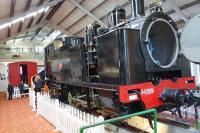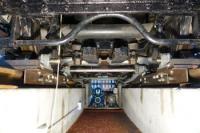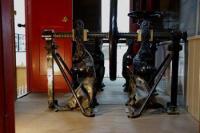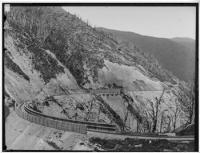The Rimutaka Incline
Over a hundred years ago more and more people came to the Wairarapa to make farms with animals and vegetables for food. People wanted to sell their meat and vegetables to people in Wellington and to get machinery and goods from the ships but there was a problem. There was a big very steep hill covered in bush between Wellington and Featherston and the farms called the Rimutaka Hill. Over the hill was a track that people could walk on or use horses to pull small carts but it was too steep for heavy loads.
The government decided that a railway was needed so they looked at very steep railways in other parts of the world. Mr Fell in England had designed a locomotive that could pull a train over very steep hills.
H 199 was the first locomotive to come. It helped to build the new track by pulling up rails and gravel. In 1878 it pulled the first carriage over the hill.
At the Museum we learned how it worked. The Fell engines are an H type locomotive which we now call the Fell Engine. It has special wheels which are underneath the engine and work horizontally by gripping onto a rail in the centre of the track. The track up the steep part called the Rimutaka Incline had three tracks instead of just two.
To come back down the incline special brake vans were needed to stop the train going too fast and crashing. There is a brake van in the museum. It has very large levers and wheels to pull on the brakes. The brakes wore out very quickly and had to be changed.
There were five engines. They pulled people and goods up and down the steep incline between Cross Creek and the Summit at the top of the hill. The other side was not so steep so ordinary locomotives could pull the trains up and down the rest of the way to Wellington and the port. The Fell locomotives did the hard work on the steep part.
The Incline had three tunnels and steep twisty corners. One corner was called Siberia. It had very steep sides. One day the wind was so strong it blew the carriages off the rails down the steep bank. Sadly four children were killed and several adults badly hurt. The engine and brake van stayed on the track as they held onto that centre line. After that accident it was decided that the engine could not push the carriages up the inline but they were to be pulled up with a brake van behind the carriages. Large fences were built to stop the wind. It was often very windy and wet and the track was often blocked by slips. When it was windy two engines were always used.
The Fell engines worked on the Incline for 77 years. H 199 worked for all the 77 years and it was used to pull up the tracks at the end.
National Library photograph
1. Rimutaka Incline railway line, including wooden barrier fences alongside, Wairarapa District. Williams, Edgar Richard, 1891-1983 :Negatives, lantern slides, stereographs, colour transparencies, monochrome prints, photographic ephemera. Ref: 1/1-025501-G. Alexander Turnbull Library, Wellington, New Zealand. http://natlib.govt.nz/records/22667369








